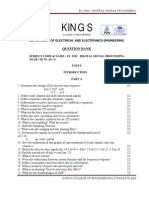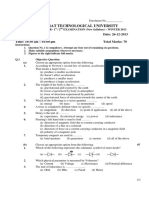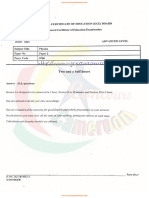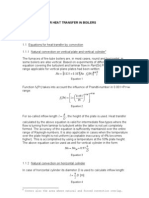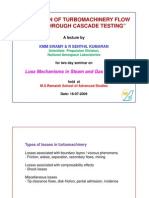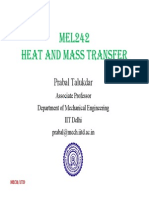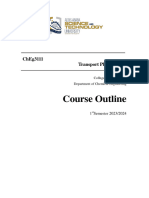ME6502 Part A B C PDF
Uploaded by
Thulasi RamME6502 Part A B C PDF
Uploaded by
Thulasi RamNSCET – QUESTION BANK
NADAR SARASWATHI COLLEGE OF ENGINEERING AND TECHNOLOGY
Vadapudupatti, Theni-625531
Question Bank
5th Semester – B.E.
Mechanical Engineering
ME-6502 – Heat & Mass Transfer
om
Part-A (10 x 2 = 20 Marks)
UNIT I - CONDUCTION
1. Define critical thickness of insulation with its significance. (2)
.c
1. Distinguish between fin efficiency and its effectiveness. (2)
1. What is meant by transient heat conduction or unsteady state conduction? (2)
ts
1. State Newton’s law of cooling or convection law. (2)
ul
1. Define overall heat transfer co-efficient. (2)
1. List out the different types of fin. (2)
es
2. State Fourier’s Law of conduction. (2)
2. Define Thermal Conductivity. (2)
r
2. Write down the equation for conduction of heat through a slab or plane wall. (2)
y2
2. Write down the equation for conduction of heat through a hollow cylinder. (2)
2. List out the different methods to enhance the effectiveness of the fin. (2)
2. Define Fourier number. (2)
2b
UNIT II - CONVECTION
3. Define Reynolds number (Re) & Prandtl number (Pr). (2)
3. Define Nusselt number (Nu). (2)
3. Define Stanton number (St). (2)
DEPARTMENT OF MECHANICAL ENGINEERING Page 2
NSCET – QUESTION BANK
3. What is meant by Newtonian and non – Newtonian fluids? (2)
3. What is meant by free or natural convection & forced convection? (2)
3. Define Rayleigh Number. (2)
4. Define boundary layer thickness (2)
What is the form of equation used to calculate heat transfer for flow through
4. (2)
cylindrical pipes?
om
Define Grashof Number and explain its significance in free convection heat
4. (2)
transfer.
4. What is meant by laminar flow and turbulent flow? (2)
4. Define convection. (2)
.c
4. Write down the equation of hydraulic diameter for a Non Circular duct. (2)
UNIT III - PHASE CHANGE HEAT TRANSFER & HEAT EXCHANGERS
5. What is meant by Fouling factor? ts (2)
ul
5. What is meant by effectiveness? (2)
5. What is meant by LMTD? (2)
es
5. What is meant by Recuperater (or) surface heat exchangers? (2)
5. What is meant by Indirect contact heat exchanger? (2)
r
5. Write the difference between parallel flow and counter flow heat exchangers. (2)
y2
6. What is meant by Film wise and Drop wise condensation? (2)
6. What is meant by pool boiling? (2)
6. Give the applications of boiling and condensation. (2)
2b
6. What is meant by compact heat exchangers? (2)
6. What are the types of heat exchangers? (2)
6. What is meant by NTU? (2)
UNIT IV - RADIATION
7. Define emissive power [E] and monochromatic emissive power. [E b] (2)
DEPARTMENT OF MECHANICAL ENGINEERING Page 3
NSCET – QUESTION BANK
7. What is meant by absorptivity, reflectivity and transmissivity? (2)
7. What is black body and gray body? (2)
7. State Planck’s distribution law. (2)
7. State Wien’s displacement law (2)
7. Define pervost theory. (2)
8. State Stefan – Boltzmann law (2)
om
8. State Kirchoff’s law of radiation. (2)
8. Define intensity of radiation (Ib). (2)
8. Define irradiation (G) and radiosity (J) (2)
.c
8. What is meant by shape factor? (2)
8. Write down the equation for heat transfer between two large grey bodies. (2)
9. What is mass transfer?
ts
UNIT V – MASS TRANSFER
(2)
ul
9. Give the examples of mass transfer. (2)
es
9. What are the modes of mass transfer? (2)
9. What is molecular diffusion? (2)
9. What is Eddy diffusion? (2)
r
y2
9. Give the examples for eddy diffusion. (2)
10. State Fick’s law of diffusion (2)
10. What is free convective mass transfer? (2)
2b
10. Define forced convective mass transfer (2)
10. Define Schmidt Number. (2)
10. Define Scherwood Number. (2)
10. Define Critical heat flux. (2)
DEPARTMENT OF MECHANICAL ENGINEERING Page 4
NSCET – QUESTION BANK
PART B (13 MARKS)
UNIT I - CONDUCTION
i) Consider a 1.2 m high and 2 m wide double-pane window consisting of two 3
mm thick layers of glass (k=0.78 W/mk) separated by a 12 mm wide stagnant air
(6)
space (k=0.026 W/mk). Determine steady rate of heat transfer through this
double-pane window & temperature of its inner surface when room is
11.a. maintained at 24˚C while the temperature of the outdoors is -5˚C. Take
convection heat transfer coefficients on the inner & outer surfaces of the window
om
to be 10 W/m2K & 25 W/m2k respectively.
(7)
ii) Derive the general 3 dimensional heat conduction equation in Cartesian
Coordinates.
A cylinder 1 m long and 5 cm in diameter is placed in an atmosphere at 45˚C. It is
provided with 10 longitudinal straight fins of material having k=120 W/mk. The
.c
height of 0.76 mm thick fins is 1.27 cm from the cylinder surface. The heat
11.a. (13)
transfer coefficient between cylinder and atmospheric air is 7 W/m2K. Calculate
the rate of heat transfer and the temperature at the end of fins if surface
temperature of cylinder is 150˚C.
ts
A pipe consists of 100 mm internal diameter and 8mm thickness carries steam at
ul
170°C. The convective heat transfer coefficient on the inner surface of pipe is 75
W/m2C. The pipe is insulated by two layers of insulation. The first layer of
insulation is 46 mm in thickness having thermal conductivity of 0.14 W/m°C. The
11.a. second layer of insulation is also 46 mm in thickness having thermal conductivity (13)
es
of 0.46 W/m°C. Ambient air temperature = 33°C. The convective heat transfer
coefficient from the outer surface of pipe = 12 W/m 2C. Thermal conductivity of
steam pipe = 46 W/m°C. Calculate the heat loss per unit length of pipe &
determine the interface temperatures. Suggest the materials used for insulation.
r
(i) An electric wire of 10 m length and 1 mm diameter dissipates 200 W in air at
y2
25°C. The convection heat transfer coefficient between the wire surface and air is
(6)
15 W/m2K. The thermal conductivity of wire is 0.582 W/mk. Calculate the
critical radius of insulation and also determine the temperature of the wire if it is
11.a. insulated to the critical thickness of insulation.
2b
(ii) A 6 cm long copper rod (k = 300 W/mk) 6 mm in diameter is exposed to an
environment at 20°C. The base temperature of the rod is maintained at 160°C.
(7)
The heat transfer coefficient is 20 W/m 2K. Calculate the heat given by the rod
and efficiency and effectiveness of the rod.
(i) Define the Biot and Fourier numbers. (3)
(ii) What is meant lumped capacity? What are the physical assumptions
necessary for a lumped capacity unsteady state analysis to apply? (4)
11.a.
(iii)A slab of Aluminium 5 cm thick initially at 200°C is suddenly immersed in a
liquid at 70°C for which the convection heat transfer co-efficient is 525 W/m2K.
DEPARTMENT OF MECHANICAL ENGINEERING Page 5
NSCET – QUESTION BANK
Determine the temperature at a depth of 12.5 mm from one of the faces 1 minute
after the immersion. Also calculate the energy removed per unit area from the
plate during 1 minute of immersion. Take P = 2700 bar, Cp = 0.9 kJ/kg˚K, (6)
k=215W/mK, ά = 8.4X 10-5 m2/s.
A wall is constructed of several layers. The first layer consists of masonry brick
20 cm. thick of thermal conductivity 0.66 W/mK, the second layer consists of 3
cm thick mortar of thermal conductivity 0.6 W/mK, the third layer consists of 8
cm thick lime stone of thermal conductivity 0.58 W/mK and the outer layer
consists of 1.2 cm thick plaster of thermal conductivity 0.6 W/mK. The heat
om
transfer coefficient on the interior and exterior of the wall are 5.6 W/m 2K and
11.b. 11 W/m2K respectively. Interior room temperature is 22C and outside air (13)
temperature is -5C.
Calculate
a) Overall heat transfer coefficient
b) Overall thermal resistance
.c
c) The rate of heat transfer
The temperature at the junction between the mortar and the limestone.
A furnace wall made up of 7.5 cm of fire plate and 0.65 cm of mild steel plate.
11.b.
ts
Inside surface exposed to hot gas at 650C and outside air temperature 27C. The
convective heat transfer co-efficient for inner side is 60 W/m2K. The convective
heat transfer co-efficient for outer side is 8W/m2K.The thermal conductivity of (13)
ul
the fire plate and mild steel plate are 0.65W/mK and 0.72W/mK respectively.
Calculate the heat lost per square meter area of the furnace wall and also find
outside surface temperature.
es
A steel tube (K = 43.26 W/mK) of 5.08 cm inner diameter and 7.62 cm outer
diameter is covered with 2.5 cm layer of insulation (K = 0.208 W/mK) the inside
surface of the tube receivers heat from a hot gas at the temperature of 316C
11.b. (13)
r
with heat transfer co-efficient of 28 W/m2K. While the outer surface exposed to
the ambient air at 30C with heat transfer co-efficient of 17 W/m2K. Calculate
y2
heat loss for 3 m length of the tube.
An aluminium alloy fin of 7 mm thick and 50 mm long protrudes from a wall,
which is maintained at 120C. The ambient air temperature is 22C. The heat
2b
transfer coefficient and conductivity of the fin material are 140 W/m2K and 55
11.b. (13)
W/mK respectively. Determine
1. Temperature at the end of the fin. 2. Temperature at the middle of the fin.
3. Total heat dissipated by the fin.
A steel ball (specific heat = 0.46 kJ/kgK. and thermal conductivity = 35 W/mK)
having 5 cm diameter and initially at a uniform temperature of 450C is suddenly
11.b. placed in a control environment in which the temperature is maintained at (13)
100C. Calculate the time required for the balls to attained a temperature of
150C. Take h = 10W/m2K.
DEPARTMENT OF MECHANICAL ENGINEERING Page 6
NSCET – QUESTION BANK
UNIT II - CONVECTION
Castor oil at 30°C flows over a flat plate at a velocity of 1.5 m/s. The length of the
plate is 4 m. The plate is heated uniformly and maintained at 90°C. Calculate the
12.a. following. I) Hydrodynamic boundary layer thickness, ii) Thermal boundary (13)
layer thickness, iii) Total drag force per unit width on one side of the plate, iv)
Heat transfer rate.
(i) A steam pipe 80 mm in diameter is covered with 30 mm thick layer of
insulation which has a surface emissivity of 0.94. The insulation surface
temperature is 85°C and the pipe is placed in atmospheric air at 15°C. If the heat
om
12.a. is lost both by radiation and free convection, find the following: i) The heat loss (13)
from 5 m length of the pipe, ii) the overall heat transfer coefficient, iii) heat
transfer coefficient due to radiation.
ii) Distinguish between free and forced convection giving examples.
Atmospheric air at 275 K and a free stream velocity of 20 m/s flows over a flat
.c
plate 1.5 m long that is maintained at a uniform temperature of 325 K. Calculate
the average heat transfer coefficient over the region where the boundary layer is
12.a. (13)
laminar, the average heat transfer coefficient over the entire length of the plate
ts
and the total heat transfer rate from the plate to the air over the length 1.5 m and
width 1 m. Assume transition occurs at Rec = 2 x 105.
ul
Cylindrical cans of 150 mm length and 65 mm diameter are to be cooled from an
initial temperature of 20°C by placing them in a cooler containing air at a
12.a. (13)
temperature of 1°C and a pressure of 1 bar. Determine the cooling rates when
the cans are kept in horizontal and vertical positions.
es
(i) Explain the concept of hydrodynamic and thermal boundary layers.
(ii) A 6 cm long section of 8 cm diameter horizontal hot water pipe passes
12.a. though a large room whose temperature is 20˚C. If the outer surface temperature (13)
r
and emissivity of the pipe are 70˚C and 0.8 respectively, determine the rate of
heat loss from the pipe by (1) natural convection (2) radiation.
y2
Air at 20C at atmospheric pressure flows over a flat plate at a velocity of 3 m/s.
if the plate is 1 m wide and 80C, calculate the following at x = 300 mm.
1. Hydrodynamic boundary layer thickness, 2. Thermal boundary layer
12.b. (13)
2b
thickness,
3. Local friction coefficient, 4. Average friction coefficient, 5. Local heat transfer
coefficient, 6. Average heat transfer coefficient, 7. Heat transfer.
Air at 290C flows over a flat plate at a velocity of 6 m/s. The plate is 1m long and
12.b. 0.5 m wide. The pressure of the air is 6 kN/m 2. If the plate is maintained at a (13)
temperature of 70C, estimate the rate of heat removed form the plate.
Air at 40C flows over a flat plate, 0.8 m long at a velocity of 50 m/s. The plate
12.b. surface is maintained at 300C. Determine the heat transferred from the entire (13)
plate length to air taking into consideration both laminar and turbulent portion
DEPARTMENT OF MECHANICAL ENGINEERING Page 7
NSCET – QUESTION BANK
of the boundary layer. Also calculate the percentage error if the boundary layer
is assumed to be turbulent nature from the very leading edge of the plate.
In a long annulus (3.125 cm ID and 5 cm OD) the air is heated by maintaining the
temperature of the outer surface of inner tube at 50C. The air enters at 16C and
12.b. (13)
leaves at 32C. Its flow rate is 30 m/s. Estimate the heat transfer coefficient
between air and the inner tube.
Engine oil flows through a 50 mm diameter tube at an average temperature of
147C. The flow velocity is 80 cm/s. Calculate the average heat transfer
12.b. (13)
coefficient if the tube wall is maintained at a temperature of 200C and it is 2 m
om
long.
UNIT III - PHASE CHANGE HEAT TRANSFER & HEAT EXCHANGERS
Water is boiled at atmospheric pressure by a horizontal polished copper heating
element of diameter D=5 mm and emissivity £=0.05 immersed in water. If the
.c
13.a. (13)
surface temperature of the heating wire is 350°C, determine the rate of heat
transfer from the wire to the water per unit length of the wire.
13.a.
ts
Steam condenses at atmospheric pressure on the external surface of the tubes of
a steam condenser. The tubes are 12 in number and each is 30 mm in diameter
and 10 m long. The inlet and outlet temperatures of cooling water flowing inside
(13)
ul
the tubes are 25°C and 60°C respectively. If the flow rate is 1.1 kg/s, calculate (i)
The rate of condensation of steam (ii) The number of transfer units (iii) The
effectiveness of the condenser.
es
Water is to be boiled at atmospheric pressure in a mechanically polished
stainless steel pan placed on top of a heating unit. The inner surface of the
13.a. bottom of the pan is maintained at l08°C. The diameter of the bottom of the pan (13)
is 30 cm. Assuming Csf = 0.0130. Calculate (i) the rate of heat transfer to the
r
water and ii) the rate of evaporation of water.
y2
A condenser is to designed to condense 600 kg/h of dry saturated steam at a
pressure of 0.12 bar. A square array of 400 tubes, each of 8 mm diameter is to be
13.a. (13)
used. The tube surface is maintained at 30C. Calculate the heat transfer
coefficient and the length of each tube.
2b
Steam at 0.080 bar is arranged to condense over a 50 cm square vertical plate.
The surface temperature is maintained at 20C. Calculate the following.
a. Film thickness at a distance of 25 cm from the top of the plate.
b. Local heat transfer coefficient at a distance of 25 cm from the top of the
plate.
13.a. (13)
c. Average heat transfer coefficient.
d. Total heat transfer
e. Total steam condensation rate.
f. What would be the heat transfer coefficient if the plate is inclined at 30C
with horizontal plane.
DEPARTMENT OF MECHANICAL ENGINEERING Page 8
NSCET – QUESTION BANK
A vertical flat plate in the form of fin is 500m in height and is exposed to steam at
13.b. atmospheric pressure. If surface of the plate is maintained at 60C. calculate the (13)
following.
Water is boiling on a horizontal tube whose wall temperature is maintained ct
15C above the saturation temperature of water. Calculate the nucleate boiling
heat transfer coefficient. Assume the water to be at a pressure of 20 atm. And
13.b. (13)
also find the change in value of heat transfer coefficient when
1. The temperature difference is increased to 30C at a pressure of 10 atm.
2. The pressure is raised to 20 atm at T = 15C.
om
A nickel wire carrying electric current of 1.5 mm diameter and 50 cm long, is
13.b. submerged in a water bath which is open to atmospheric pressure. Calculate the (13)
voltage at the burn out point, if at this point the wire carries a current of 200A.
Water is boiled at the rate of 24 kg/h in a polished copper pan, 300 mm in
13.b. diameter, at atmospheric pressure. Assuming nucleate boiling conditions (13)
.c
calculate the temperature of the bottom surface of the pan.
Water enters a cross flow Heat exchanger (both fluids unmixed) at 5°C and flows
13.b.
ts
at the rate of 4600 kg/h to cool 4000 kg/h of air that is initially at 40°C. Assume
the overall heat transfer coefficient value to be 150 W/m 2K. For an exchanger
surface area of 25m2, calculate the exit temperature of air and water.
(13)
ul
UNIT IV - RADIATION
(i) Two equal and parallel discs of diameter 25 cm are separated by a distance of
es
50 cm. If the discs are maintained at 600°C and 250°C. Calculate the radiation
(6)
14.a. heat exchange between them.
(7)
(ii) Define the following terms: Monochromatic emissivity, Grey Body, Shape
factor.
r
(i) Discuss how the radiation from gases differs from that of solids.
y2
(ii) Two very large parallel plates with emissivities 0.5 exchange heat. Determine (5)
14.a.
the percentage reduction in the heat transfer rate if a polished aluminium (8)
radiation shield of £ = 0.04 is placed in between the plates.
2b
Two rectangles 50 x 50 cm are placed perpendicular with common edge. One
surface has T1 = 1000 K, ε = 0.6, while the other surface is insulated and in
14.a. (13)
radiant balance with a large surrounding room at 300 K. Determine the
temperature of the insulated surface and heat lost by the surface at 1000 K.
Two parallel plates of size 1.0 m x 1.0 m spaced 0.5 m apart are located in very
large room; the walls are maintained at a temperature of 27°C. One plate is
maintained at a temperature of 900°C and the other at 400°C. Their emissivities
14.a. (13)
are 0.2 and 0.5 respectively. If the plates exchange heat between themselves and
surroundings, find the heat transfer to each plate and to them. Consider only the
plate surfaces facing each other.
DEPARTMENT OF MECHANICAL ENGINEERING Page 9
NSCET – QUESTION BANK
State and prove the following laws:
(1) Kirchhoff’s law of radiation
(2) Stefan - Boltzmann law.
14.a. (13)
Show-from energy-balance consideration that the radiation heat transfer from a
plane composite surface area A4 and made up of plane surface areas A 2 and A3 to
a plane surface area Al is given by: A 4F41=A3F31+A2F21& F14=F12+F13
A black body at 3000 K emits radiation. Calculate the following:
i) Monochromatic emissive power at 7 m wave length.
ii) Wave length at which emission is maximum.
14.b. iii) Maximum emissive power. (13)
om
iv) Total emissive power,
v) Calculate the total emissive of the furnace if it is assumed as a real
surface having emissivity equal to 0.85.
Assuming sun to be black body emitting radiation at 6000 K at a mean distance
14.b. of 12 1010 m from the earth. The diameter of the sun is 1.5 109 m and that of (13)
.c
the earth is 13.2 106 m. Calculation the following.
Two black square plates of size 2 by 2 m are placed parallel to each other at a
14.b.
ts
distance of 0.5 m. One plate is maintained at a temperature of 1000C and the
other at 500C. Find the heat exchange between the plates.
(13)
ul
Two parallel plates of size 3 m 2 m are placed parallel to each other at a
distance of 1 m. One plate is maintained at a temperature of 550C and the other
at 250C and the emissivities are 0.35 and 0.55 respectively. The plates are
14.b. (13)
es
located in a large room whose walls are at 35C. If the plates located exchange
heat with each other and with the room, calculate.
1. Heat lost by the plates, 2. Heat received by the room.
A gas mixture contains 20% CO2 and 10% H2o by volume. The total pressure is 2
r
14.b. atm. The temperature of the gas is 927C. The mean beam length is 0.3 m. (13)
y2
Calculate the emissivity of the mixture.
UNIT V – MASS TRANSFER
(i) A 3-cm-diameter Stefan tube is used to measure the binary diffusion
2b
coefficient of water vapor in air at 20°C at an elevation of 1600 m where the
atmospheric pressure is 83.5 kPa. The tube is partially filled with water, and the
distance from the water surface to the open end of the tube is 40 cm. Dry air is
blown over the open end of the tube so that water vapor rising to the top is (8)
15.a.
removed immediately and the concentration of vapor at the top of the tube is
zero. In 15 days of continuous operation at constant pressure and temperature,
the amount of water that has evaporated is measured to be 1.23 g. Determine the
diffusion coefficient of water vapor in air at 20°C and 83.5 kPa (5)
ii) State some analogies between heat and mass transfer.
15.a. (i) A thin plastic membrane separates hydrogen from air. The molar (7)
DEPARTMENT OF MECHANICAL ENGINEERING Page 10
NSCET – QUESTION BANK
concentrations of hydrogen in the membrane at the inner and outer surfaces are (6)
determined to be 0.065 and 0.003 kmol/m 3, respectively. The binary diffusion
coefficient of hydrogen in plastic at the operation temperature is 5.3x10 -10 m2/s.
Determine the mass flow rate of hydrogen by diffusion through the membrane
under steady conditions if the thickness of the membrane is (a) 2 mm and (b) 0.5
mm.
(ii) Dry air at 15°C and 92 kPa flows over a 2 m long wet surface with a free
stream velocity of 4 m/s. Determine the average mass transfer coefficient.
(i) Air at 1.01 bar and 30 °C flows past a tray full of water with a velocity of 2
m/s. The partial pressure of water vapour is 0.7 KPa and the saturation pressure
om
is 3.17 KPa. The tray measures 40 cm along the flow direction and has a width of
20 cm. Calculate the evaporation rate of water if the temperature on the water
(7)
15.a. surface is 25 °C. Assume the following v = 15 x 10-6 m2/s and diffusivity, D =
(6)
0.145 m2/h.
(ii) Water at atmospheric pressure is to be boiled in polished copper pan. The
diameter of the pan is 350 mm and is kept at 115 °C. Calculate the following, (i)
.c
power of the burner, (ii) rate of evaporation in kg/hr, (iii) critical heat flux.
(i) Air is contained in a tyre tube of surface area 0.5 m2 & wall thickness 10 mm,
ts
pressure of air drops from 2.2 bar to 2.18 bar in a period of 6 days. The solubility
of air in rubber is 0.072 m3 of air per m3 of rubber at 1 bar. Determine the
diffusivity of air in rubber at operating temperature of 300 K if volume of air in
(7)
ul
15.a. the tube is 0.028 m3.
(6)
(ii) Dry air at 20°C (ρ = 1.2 kg/m 3, v = 15 x l0-6 m2/s, D = 4.2 x l0-5 m2/s) flows
over a flat plate of length 50 cm which is covered with a thin layer of water at a
es
velocity of 1 m/s. Estimate the local mass transfer coefficient at a distance of 10
cm from the leading edge and the average mass transfer coefficient.
(i) Explain Fick's first and second laws of diffusion.
(3)
(ii)Discuss the analogy between heat and mass transfer.
r
15.a. (3)
(iii)Explain the phenomenon of equimolar counter diffusion. Derive an
(7)
y2
expression for equimolar counter diffusion between two gases or liquids.
(i) A thin plastic membrane separates hydrogen from air. The molar
concentrations of hydrogen in the membrane at the inner and outer surfaces are
determined to be 0.065 and 0.003 kmol/m 3, respectively. The binary diffusion
2b
coefficient of hydrogen in plastic at the operation temperature is 5.3x10 -10 m2/s.
(7)
15.b. Determine the mass flow rate of hydrogen by diffusion through the membrane
(6)
under steady conditions if the thickness of the membrane is (a) 2 mm and (b) 0.5
mm.
(ii) Dry air at 15°C and 92 kPa flows over a 2 m long wet surface with a free
stream velocity of 4 m/s. Determine the average mass transfer coefficient.
(i) Air at 1.01 bar and 30 °C flows past a tray full of water with a velocity of 2
m/s. The partial pressure of water vapour is 0.7 KPa and the saturation pressure (7)
15.b.
is 3.17 KPa. The tray measures 40 cm along the flow direction and has a width of (6)
20 cm. Calculate the evaporation rate of water if the temperature on the water
DEPARTMENT OF MECHANICAL ENGINEERING Page 11
NSCET – QUESTION BANK
surface is 25 °C. Assume the following v = 15 x 10 -6 m2/s and diffusivity, D =
0.145 m2/h. (ii) Water at atmospheric pressure is to be boiled in polished copper
pan. The diameter of the pan is 350 mm and is kept at 115 °C. Calculate the
following, (i) power of the burner, (ii) rate of evaporation in kg/hr, (iii) critical
heat flux.
(i) Air is contained in a tyre tube of surface area 0.5 m2 & wall thickness 10 mm,
pressure of air drops from 2.2 bar to 2.18 bar in a period of 6 days. The solubility
of air in rubber is 0.072 m3 of air per m3 of rubber at 1 bar. Determine the
(7)
diffusivity of air in rubber at operating temperature of 300 K if volume of air in
15.b. the tube is 0.028 m3.
om
(ii) Dry air at 20°C (ρ = 1.2 kg/m3, v = 15 x l0-6 m2/s, D = 4.2 x l0-5 m2/s) flows
(6)
over a flat plate of length 50 cm which is covered with a thin layer of water at a
velocity of 1 m/s. Estimate the local mass transfer coefficient at a distance of 10
cm from the leading edge and the average mass transfer coefficient.
(i) Explain Fick's first and second laws of diffusion.
.c
(3)
(ii)Discuss the analogy between heat and mass transfer.
15.b. (3)
(iii)Explain the phenomenon of equimolar counter diffusion. Derive an
(7)
expression for equimolar counter diffusion between two gases or liquids.
15.b. ts
Air at 10C with a velocity of 3 m/s flows over a flat plate. The plate is 0.3 m long.
Calculate the mass transfer coefficient.
(13)
ul
PART C (15 MARKS)
es
UNIT I - CONDUCTION
Radius of insulation provided in the steam pipe is greater than the critical radius
16.a. (15)
of insulation. Justify. Why?
r
Radius of insulation provided in the Electrical wire is less than the critical radius
y2
16.a. (15)
of insulation. Justify. Why?
UNIT II - CONVECTION
16.a. Free convection is caused by Buoyancy force. Justify. Why? (15)
2b
When Prandtl No is equal to one, Thermal boundary layer and Hydrodynamic
16.a. (15)
boundary layer are equal. Justify
UNIT III - PHASE CHANGE HEAT TRANSFER & HEAT EXCHANGERS
16.a. Scale due to detoriation causes fouling resistance. Justify. (15)
16.b. Cross flow heat exchangers have high effectiveness. Justify. (15)
UNIT IV - RADIATION
DEPARTMENT OF MECHANICAL ENGINEERING Page 12
NSCET – QUESTION BANK
16.b. Discuss the effect of Radiation on measurement of temperature of gases. (15)
Net heat exchange between two large black bodies is zero. Justify .Explain with
16.b. (15)
the suitable example.
UNIT V – MASS TRANSFER
Molecular Diffusion is the best method of mass transfer. Justify. If not Which one
16.b. (15)
is the best method. Discuss in Detail.
Eddy diffusion is the best method of mass transfer. Justify. If not Which one is the
16.b. (15)
om
best method. Discuss in Detail.
.c
ts
ul
r es
y2
2b
DEPARTMENT OF MECHANICAL ENGINEERING Page 13
You might also like
- Midsem Exam Question Paper: Semester: 3 Subject: Fluid Flow Operation (3130502)0% (1)Midsem Exam Question Paper: Semester: 3 Subject: Fluid Flow Operation (3130502)2 pages
- Mole concept, and quantintaive aspects of chemical changeNo ratings yetMole concept, and quantintaive aspects of chemical change17 pages
- Beginning of Term Ii 2019 Exam S.5 Physics P510/1 Time: 2 Hours Instructions Assume Where NecessaryNo ratings yetBeginning of Term Ii 2019 Exam S.5 Physics P510/1 Time: 2 Hours Instructions Assume Where Necessary3 pages
- Xiith Physics - II - Theory Prelim - 2 (35 Marks)No ratings yetXiith Physics - II - Theory Prelim - 2 (35 Marks)2 pages
- Bachelor of Science (B.SC.) Semester-II (C.B.S.) Examination Physics (Oscillations, Kinetic Theory of Gases and Thermodynamics) Compulsory Paper-1No ratings yetBachelor of Science (B.SC.) Semester-II (C.B.S.) Examination Physics (Oscillations, Kinetic Theory of Gases and Thermodynamics) Compulsory Paper-13 pages
- GSQ/M-20 Physics Paper XI Solid State and Nano-Physics: Roll No. .......................... Total Pages: 03No ratings yetGSQ/M-20 Physics Paper XI Solid State and Nano-Physics: Roll No. .......................... Total Pages: 033 pages
- Course Code: PHT 101 Itsj/Rw - 17 / 1007 First / Second Semester Bachelor of Engineering ExaminationNo ratings yetCourse Code: PHT 101 Itsj/Rw - 17 / 1007 First / Second Semester Bachelor of Engineering Examination3 pages
- Kings: Department of Electrical and Electronics EngineeringNo ratings yetKings: Department of Electrical and Electronics Engineering7 pages
- Cambridge Institute of Technology: Department of Mechanical Engineering Heat Transfer Important Theory QuestionsNo ratings yetCambridge Institute of Technology: Department of Mechanical Engineering Heat Transfer Important Theory Questions4 pages
- 7HGVOKMUdb0jyKbU3Vv2--2502-3328 - Subject - Advanced Engineering Materials - Year - B.Tech. Second Semester %28All Branches%29 - %28Fire Engineering%29 %28C.B.C.S.%29 Winter 2022No ratings yet7HGVOKMUdb0jyKbU3Vv2--2502-3328 - Subject - Advanced Engineering Materials - Year - B.Tech. Second Semester %28All Branches%29 - %28Fire Engineering%29 %28C.B.C.S.%29 Winter 20224 pages
- PSEB-Class-12-Physics-Sample-Paper-Set-1No ratings yetPSEB-Class-12-Physics-Sample-Paper-Set-14 pages
- Analysis of Pressure Drop and Effectiveness in Micro Cross-Flow Heat ExchangerNo ratings yetAnalysis of Pressure Drop and Effectiveness in Micro Cross-Flow Heat Exchanger15 pages
- AIATS Medical-2014 - Test-6 (Code-A) 02-02-2014 PDFNo ratings yetAIATS Medical-2014 - Test-6 (Code-A) 02-02-2014 PDF40 pages
- Engineering Physics 2023 June (2019 Ad) CS EC ITNo ratings yetEngineering Physics 2023 June (2019 Ad) CS EC IT2 pages
- EM 418 UNIT 2 Damped Free Vibration - Viscous Damping and Coulomb DampingNo ratings yetEM 418 UNIT 2 Damped Free Vibration - Viscous Damping and Coulomb Damping108 pages
- Year - B.Sc. CBCS Pattern Semester-VI Subject - CHT14 - Chemistry Paper-II - Discipline Specific Elective Chemistry VI - Physical ChemistryNo ratings yetYear - B.Sc. CBCS Pattern Semester-VI Subject - CHT14 - Chemistry Paper-II - Discipline Specific Elective Chemistry VI - Physical Chemistry2 pages
- EC1402 Optical Communication Nov Dec 2007No ratings yetEC1402 Optical Communication Nov Dec 20073 pages
- Tech Sciences p2 Gr11 QP Nov2019 - Eng DNo ratings yetTech Sciences p2 Gr11 QP Nov2019 - Eng D17 pages
- HEAT AND MASS TRANSFER Question Paper 21 22 1No ratings yetHEAT AND MASS TRANSFER Question Paper 21 22 13 pages
- Test-5_Daily Practice Subjective Paper_NEET_12th_Question Paper (20-12-2024)No ratings yetTest-5_Daily Practice Subjective Paper_NEET_12th_Question Paper (20-12-2024)2 pages
- Tutorialquestions Reheatrankinecycle 130225131731 Phpapp02No ratings yetTutorialquestions Reheatrankinecycle 130225131731 Phpapp028 pages
- Teachers Recruitment Board: 1. Important DatesNo ratings yetTeachers Recruitment Board: 1. Important Dates13 pages
- Five Days Summer Workshop in "Libre CAD Open Source Drafting SoftwareNo ratings yetFive Days Summer Workshop in "Libre CAD Open Source Drafting Software5 pages
- Esterification of Used Maduca Oil Using Theheterogeneous Mgo / Zro Catalyst For Production of BiodieselNo ratings yetEsterification of Used Maduca Oil Using Theheterogeneous Mgo / Zro Catalyst For Production of Biodiesel46 pages
- Warm Space: Basic Civil and Mechanical Engineering Unit VNo ratings yetWarm Space: Basic Civil and Mechanical Engineering Unit V11 pages
- 07A - Chapter 7 - Sec 7.1-7.3, App F - BlackNo ratings yet07A - Chapter 7 - Sec 7.1-7.3, App F - Black14 pages
- Shock Boundary Layer Interactions – A MultiphysicsNo ratings yetShock Boundary Layer Interactions – A Multiphysics92 pages
- Boundary Layer: Hydraulics and HydrologyNo ratings yetBoundary Layer: Hydraulics and Hydrology49 pages
- Instability Analysis of Laminar Flows: Professor Mechanical Engineering Department IitdelhiNo ratings yetInstability Analysis of Laminar Flows: Professor Mechanical Engineering Department Iitdelhi22 pages
- Estimation of Turbomachinery Losses Through Cascade TestingNo ratings yetEstimation of Turbomachinery Losses Through Cascade Testing54 pages
- A Thorough Description of How Wall Functions Are Implemented in OpenfoamNo ratings yetA Thorough Description of How Wall Functions Are Implemented in Openfoam30 pages
- Building and Environment: Yezhan Li, Wei Wang, Tsubasa OkazeNo ratings yetBuilding and Environment: Yezhan Li, Wei Wang, Tsubasa Okaze15 pages
- Coulson and Richardson S Chemical Engineering Volume 1B Heat and Mass Transfer Fundamentals and Applications Seventh Edition. Edition Chhabra100% (6)Coulson and Richardson S Chemical Engineering Volume 1B Heat and Mass Transfer Fundamentals and Applications Seventh Edition. Edition Chhabra52 pages
- Midsem Exam Question Paper: Semester: 3 Subject: Fluid Flow Operation (3130502)Midsem Exam Question Paper: Semester: 3 Subject: Fluid Flow Operation (3130502)
- Mole concept, and quantintaive aspects of chemical changeMole concept, and quantintaive aspects of chemical change
- Beginning of Term Ii 2019 Exam S.5 Physics P510/1 Time: 2 Hours Instructions Assume Where NecessaryBeginning of Term Ii 2019 Exam S.5 Physics P510/1 Time: 2 Hours Instructions Assume Where Necessary
- Bachelor of Science (B.SC.) Semester-II (C.B.S.) Examination Physics (Oscillations, Kinetic Theory of Gases and Thermodynamics) Compulsory Paper-1Bachelor of Science (B.SC.) Semester-II (C.B.S.) Examination Physics (Oscillations, Kinetic Theory of Gases and Thermodynamics) Compulsory Paper-1
- GSQ/M-20 Physics Paper XI Solid State and Nano-Physics: Roll No. .......................... Total Pages: 03GSQ/M-20 Physics Paper XI Solid State and Nano-Physics: Roll No. .......................... Total Pages: 03
- Course Code: PHT 101 Itsj/Rw - 17 / 1007 First / Second Semester Bachelor of Engineering ExaminationCourse Code: PHT 101 Itsj/Rw - 17 / 1007 First / Second Semester Bachelor of Engineering Examination
- Kings: Department of Electrical and Electronics EngineeringKings: Department of Electrical and Electronics Engineering
- Cambridge Institute of Technology: Department of Mechanical Engineering Heat Transfer Important Theory QuestionsCambridge Institute of Technology: Department of Mechanical Engineering Heat Transfer Important Theory Questions
- 7HGVOKMUdb0jyKbU3Vv2--2502-3328 - Subject - Advanced Engineering Materials - Year - B.Tech. Second Semester %28All Branches%29 - %28Fire Engineering%29 %28C.B.C.S.%29 Winter 20227HGVOKMUdb0jyKbU3Vv2--2502-3328 - Subject - Advanced Engineering Materials - Year - B.Tech. Second Semester %28All Branches%29 - %28Fire Engineering%29 %28C.B.C.S.%29 Winter 2022
- Analysis of Pressure Drop and Effectiveness in Micro Cross-Flow Heat ExchangerAnalysis of Pressure Drop and Effectiveness in Micro Cross-Flow Heat Exchanger
- AIATS Medical-2014 - Test-6 (Code-A) 02-02-2014 PDFAIATS Medical-2014 - Test-6 (Code-A) 02-02-2014 PDF
- EM 418 UNIT 2 Damped Free Vibration - Viscous Damping and Coulomb DampingEM 418 UNIT 2 Damped Free Vibration - Viscous Damping and Coulomb Damping
- Year - B.Sc. CBCS Pattern Semester-VI Subject - CHT14 - Chemistry Paper-II - Discipline Specific Elective Chemistry VI - Physical ChemistryYear - B.Sc. CBCS Pattern Semester-VI Subject - CHT14 - Chemistry Paper-II - Discipline Specific Elective Chemistry VI - Physical Chemistry
- Test-5_Daily Practice Subjective Paper_NEET_12th_Question Paper (20-12-2024)Test-5_Daily Practice Subjective Paper_NEET_12th_Question Paper (20-12-2024)
- Properties of Group-IV, III-V and II-VI SemiconductorsFrom EverandProperties of Group-IV, III-V and II-VI Semiconductors
- Physical Properties of High-Temperature SuperconductorsFrom EverandPhysical Properties of High-Temperature Superconductors
- Tutorialquestions Reheatrankinecycle 130225131731 Phpapp02Tutorialquestions Reheatrankinecycle 130225131731 Phpapp02
- Five Days Summer Workshop in "Libre CAD Open Source Drafting SoftwareFive Days Summer Workshop in "Libre CAD Open Source Drafting Software
- Esterification of Used Maduca Oil Using Theheterogeneous Mgo / Zro Catalyst For Production of BiodieselEsterification of Used Maduca Oil Using Theheterogeneous Mgo / Zro Catalyst For Production of Biodiesel
- Warm Space: Basic Civil and Mechanical Engineering Unit VWarm Space: Basic Civil and Mechanical Engineering Unit V
- Shock Boundary Layer Interactions – A MultiphysicsShock Boundary Layer Interactions – A Multiphysics
- Instability Analysis of Laminar Flows: Professor Mechanical Engineering Department IitdelhiInstability Analysis of Laminar Flows: Professor Mechanical Engineering Department Iitdelhi
- Estimation of Turbomachinery Losses Through Cascade TestingEstimation of Turbomachinery Losses Through Cascade Testing
- A Thorough Description of How Wall Functions Are Implemented in OpenfoamA Thorough Description of How Wall Functions Are Implemented in Openfoam
- Building and Environment: Yezhan Li, Wei Wang, Tsubasa OkazeBuilding and Environment: Yezhan Li, Wei Wang, Tsubasa Okaze
- Coulson and Richardson S Chemical Engineering Volume 1B Heat and Mass Transfer Fundamentals and Applications Seventh Edition. Edition ChhabraCoulson and Richardson S Chemical Engineering Volume 1B Heat and Mass Transfer Fundamentals and Applications Seventh Edition. Edition Chhabra









